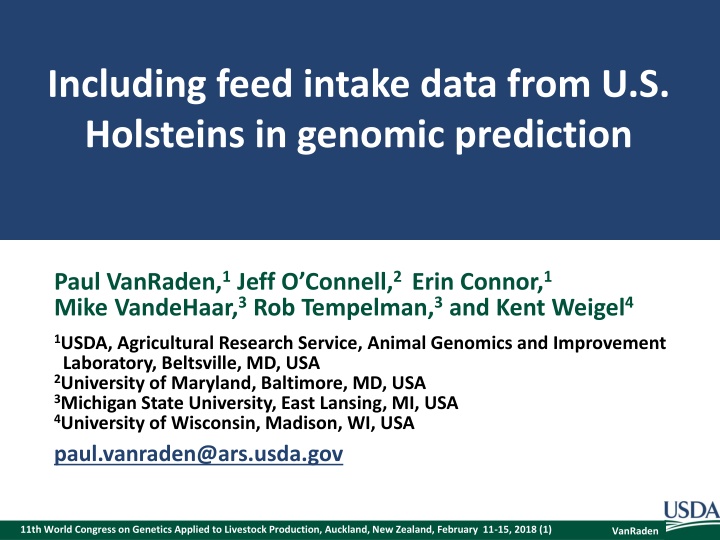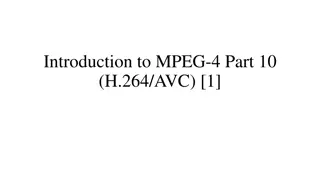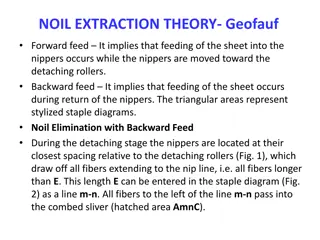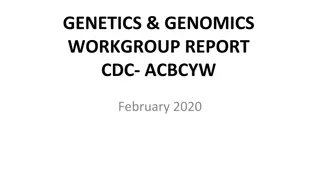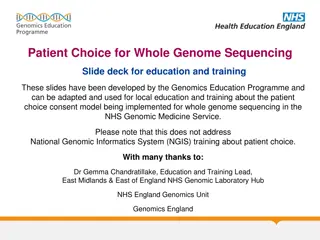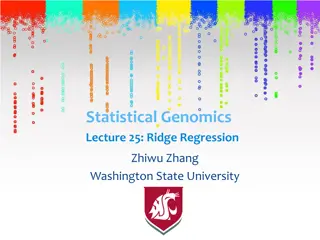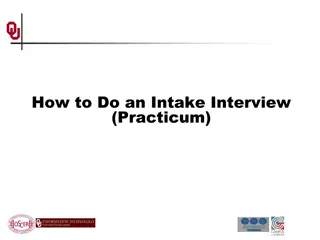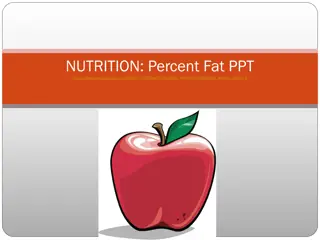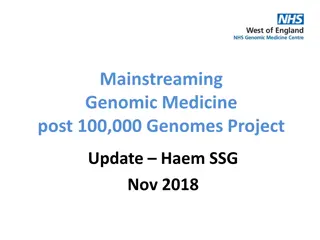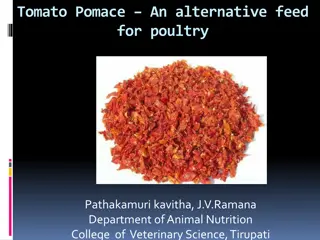Genomic Prediction of Feed Intake in U.S. Holsteins
This study discusses the inclusion of feed intake data from U.S. Holsteins in genomic prediction, focusing on residual feed intake (RFI) as a new trait. The research involves data from research herds and genotypes of cows, with genetic evaluation models and genomic evaluation for predicting feed intake in Holsteins. The study aims to enhance the accuracy and efficiency of predicting feed intake using genomic information. Economic value, reliability of predictions, and genetic correlations are also analyzed in detail.
Download Presentation

Please find below an Image/Link to download the presentation.
The content on the website is provided AS IS for your information and personal use only. It may not be sold, licensed, or shared on other websites without obtaining consent from the author.If you encounter any issues during the download, it is possible that the publisher has removed the file from their server.
You are allowed to download the files provided on this website for personal or commercial use, subject to the condition that they are used lawfully. All files are the property of their respective owners.
The content on the website is provided AS IS for your information and personal use only. It may not be sold, licensed, or shared on other websites without obtaining consent from the author.
E N D
Presentation Transcript
Including feed intake data from U.S. Holsteins in genomic prediction Paul VanRaden,1Jeff O Connell,2 Erin Connor,1 Mike VandeHaar,3Rob Tempelman,3and Kent Weigel4 1USDA, Agricultural Research Service, Animal Genomics and Improvement Laboratory, Beltsville, MD, USA 2University of Maryland, Baltimore, MD, USA 3Michigan State University, East Lansing, MI, USA 4University of Wisconsin, Madison, WI, USA paul.vanraden@ars.usda.gov 11th World Congress on Genetics Applied to Livestock Production, Auckland, New Zealand, February 11-15, 2018 (1) VanRaden
Feed intake topics Residual feed intake (RFI) as a new trait Data included, models, and parameters Reliability of predictions Economic value of feed saved Reporting of feed intake evaluations 11th World Congress on Genetics Applied to Livestock Production, Auckland, New Zealand, February 11-15, 2018 (2) VanRaden
Feed intake data Research herd Univ. of Wisconsin and US Dairy Forage Res. Ctr. Iowa State Univ. ARS, USDA (Beltsville, MD) Univ. of Florida Michigan State Univ. Cows 1,390 Records 1,678 Researchers Weigel, Armentano Spurlock Connor Staples VandeHaar, Tempelman Davidson Hanigan Dann $5 million AFRI grant 953 534 491 273 1,006 834 582 315 Purina Anim. Nutr. Ctr. (MO) Virginia Tech Miner Agric. Res. Inst. (NY) All 151 93 58 184 93 58 3,965 4,823 11th World Congress on Genetics Applied to Livestock Production, Auckland, New Zealand, February 11-15, 2018 (3) VanRaden
Genotypes of research cows Chip densities (number of markers) used 502 high density (777K) 1341 GHD or GH2 (77K or 140K) 1251 50K or ZMD (50K) 411 low density (7K to 20K) Imputed to 60,671 subset used officially 11th World Congress on Genetics Applied to Livestock Production, Auckland, New Zealand, February 11-15, 2018 (4) VanRaden
National RFI genomic evaluation RFI from research cows already adjusted for phenotypic correlations with milk net energy, metabolic body weight, and weight change Genetic evaluation model: RFI = breeding value + permanent environment + herd sire + management group + age-parity + b1(inbreeding) + b2(GPTAmilk net energy) + b3(GPTABW composite) Remove remaining genetic correlations and include 60 million nongenotyped Holsteins Genomic model: Predict 1.4 million genotyped Holsteins 11th World Congress on Genetics Applied to Livestock Production, Auckland, New Zealand, February 11-15, 2018 (5) VanRaden
Variance estimates for RFI (and SCS) Parameter Heritability (%) Repeatability (%) Phenotypic correlation with yield Genetic correlation with yield RFI 14 24 0.00 0.00 SCS 16 35 0.10 0.03 SCS provided a 2nd trait with similar properties, which allowed genomic predictions from research cows to be compared with national SCS predictions 11th World Congress on Genetics Applied to Livestock Production, Auckland, New Zealand, February 11-15, 2018 (6) VanRaden
Estimation of genomic reliability Correlation of genomic predictions from research cow data (GEBVr) vs. national data (GEBVn) for SCS Observed REL = corr(GEBVr , GEBVn)2 * national REL 5-way cross-validation Use RFI records of 80% of cows to predict RFI records of remaining 20% Exclude cows from the validation data if they had daughters in the reference data Observed REL = corr(GEBVr , RFI)2 / heritability Choose discount to match computed to observed REL 11th World Congress on Genetics Applied to Livestock Production, Auckland, New Zealand, February 11-15, 2018 (7) VanRaden
Computed vs. actual GREL for SCS Expected genomic reliability of young animals was 19% for both RFI and SCS using standard discount of 0.7 SCS GPTA correlated by only 0.39 for national vs. research-cow reference data Observed REL of SCS was (0.39)2 72% = 11% Genomic REL was discounted by a factor of 0.3 to agree with Var(PTA) for RFI and observed REL of SCS 11th World Congress on Genetics Applied to Livestock Production, Auckland, New Zealand, February 11-15, 2018 (8) VanRaden
5-way cross-validation Trait Reliability method Reliability Genomic Traditional Difference RFI Observed Expected1 13.4 18.1 +4.7 14.0 21.2 +7.2 SCS Observed Expected1 17.6 23.0 +5.4 16.4 24.7 +8.3 1Expected REL calculated from parent average for cows not in the reference, or from genomic REL calculated using a discount factor of 0.3. 11th World Congress on Genetics Applied to Livestock Production, Auckland, New Zealand, February 11-15, 2018 (9) VanRaden
RFI reliability by animal group Animal group RFI Reliability (%) Traditional Genomic1 3,965 cows with RFI phenotypes 30 34 Top 10 sires with most RFI daughters 78 85 Top 100 Net Merit progeny tested sires 8 16 Top 100 Net Merit young bulls 3 12 1.5 million genotyped Holsteins 5 13 60 million non-genotyped Holsteins 3 3 1Computed with discount factor of 0.3 11th World Congress on Genetics Applied to Livestock Production, Auckland, New Zealand, February 11-15, 2018 (10) VanRaden
Economic values Milk production (3.5% F, 3.0% P) $0.17 $4,250 $0.253 Dry matter intake $0.12 $1,992 $0.336 Residual feed intake $0.12 0 $0.336 Statistic Price/pound Mean income or cost/lactation Lifetime value/pound (2.8 lactations) Relative value (% of NM$) 36% 16% Since 2000, Net Merit $ has selected for smaller cows using type traits (body weight composite) to reduce expected feed intake (-6% of NM$) Economic values for yield and BWC already account for correlated feed intake, and RFI measures uncorrelated intake 11th World Congress on Genetics Applied to Livestock Production, Auckland, New Zealand, February 11-15, 2018 (11) VanRaden
Reporting feed efficiency Feed efficiency expected from yield and type traits FE$ is milk income feed cost expected from PTAs for milk, fat, protein, and body weight composite (type) Current definition used in TPI New FE$ = FE$ RFI$ Feed saved (used in AUS , also USA proposal) FeedSaved$ combines RFI$ and regression on body weight composite, but not yield trait regressions 11th World Congress on Genetics Applied to Livestock Production, Auckland, New Zealand, February 11-15, 2018 (12) VanRaden
Economic progress Ratio of progress from new vs. old index is square root of [RELNM$(1942) + RELRFI(702)]/[RELNM$(1942)] Ratio of progress is small (1.01) because RELRFI (12%) is much lower than RELNM$ (75%) Extra 1% faster progress is worth $4.5 million per year to the U.S. dairy industry 11th World Congress on Genetics Applied to Livestock Production, Auckland, New Zealand, February 11-15, 2018 (13) VanRaden
Early feed intake studies at USDA Hooven et al., JDS 51:1409 1419, 1968 661 lactations of 318 Holstein cows at Beltsville Genetic correlation (feed efficiency, milk energy) = 0.92 Hooven et al., JDS 55:1113 1122, 1972 10-mo intake trials for 425 cows 30-d trial (month 5) gave 89% of progress 11th World Congress on Genetics Applied to Livestock Production, Auckland, New Zealand, February 11-15, 2018 (14) VanRaden
Conclusions Producers and researchers have always wanted to measure and select for feed efficiency RFI could get ~16% of relative emphasis in net merit, but low REL of ~12% for young animals will limit progress Genomics can multiply feed intake information from a few herds to thousands of other herds Higher REL will require more research herds or international cooperation 11th World Congress on Genetics Applied to Livestock Production, Auckland, New Zealand, February 11-15, 2018 (15) VanRaden
Acknowledgments Agriculture and Food Research Initiative Competitive Grant #2011-68004-30340 from USDA National Institute of Food and Agriculture (feed intake funding) USDA-ARS project 1265-31000-101-00, Improving Genetic Predictions in Dairy Animals Using Phenotypic and Genomic Information (AGIL funding) Council on Dairy Cattle Breeding and dairy industry contributors for pedigree and genomic data Jim Liesman (MSU) for merging and editing phenotypes George Wiggans for managing genotypes 11th World Congress on Genetics Applied to Livestock Production, Auckland, New Zealand, February 11-15, 2018 (16) VanRaden
6-week or 4-week trials 6-week 42 4,621 0 1.68 1.00 1.00 $700 4-week 28 202 0 1.75 0.96 0.92 $500 Days of feed intake Cows recorded RFI mean RFI standard deviation (kg/day) Correlation with 6-week trial Weighted in statistical model Approximate cost of recording (+1 week pre-trial) 11th World Congress on Genetics Applied to Livestock Production, Auckland, New Zealand, February 11-15, 2018 (17) VanRaden
